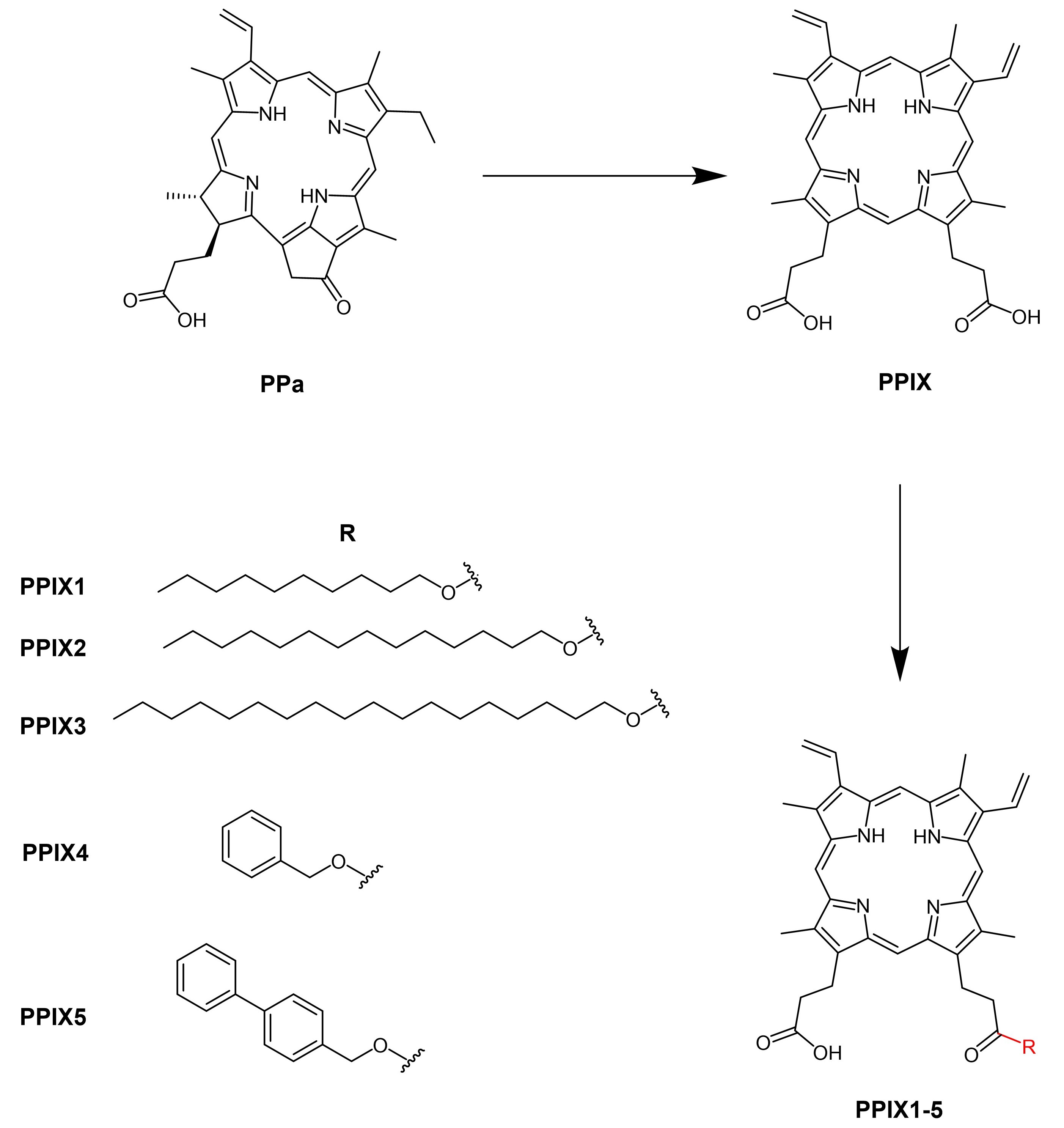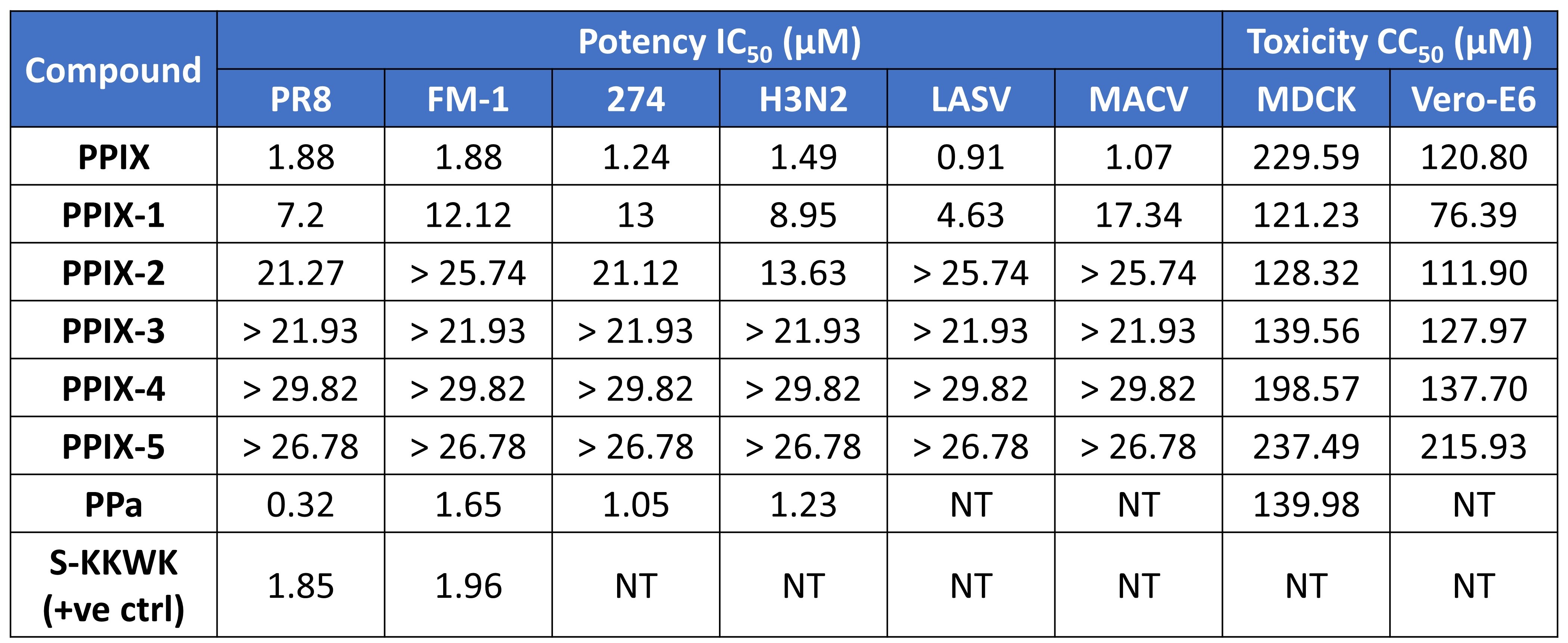Broad-spectrum antivirals of protoporphyrins inhibit the entry of highly pathogenic emerging viruses
Posted on: 23 May 2020
Preprint posted on 10 May 2020
Article now published in Bioorganic Chemistry at http://dx.doi.org/10.1016/j.bioorg.2020.104619
Antiviral prototype hype: researchers develop protoporphyrins to inhibit viral entry
Selected by Zhang-He GohCategories: microbiology, pharmacology and toxicology
Background of preprint
The frequent recurrence of viral outbreaks in the past two decades—the most recent being the COVID-19 pandemic in December 2019—have spurred researchers to develop antivirals with new mechanisms of action. Because a third of all emerging and re-emerging infections are caused by RNA viruses [1], Lu et al. focus on identifying antivirals against these targets.
Previous work by the lab discovered that a porphyrin derivative, PPa, exhibited an antiviral effect in early stages of viral infections by interacting with the virion lipid bilayer, thus blocking entry of the virion into host cells [2]. This allowed PPa to be active against various Influenza A viruses. In this preprint, Lu et al. build on their previous work (Fig. 1): they investigated the derivatives of protoporphyrin IX (PPIX), and tested the antiviral activity of PPIX against Lassa virus (LASV), Machupo virus (MACV), SARS-CoV-2, and influenza A viruses (IAV).

Figure 1. Porphyrins investigated by Lu et al. in this preprint.
Key findings of preprint
Lu et al. tested a range of 6 PPIX derivatives against various enveloped viruses and cells to demonstrate their potency, efficacy, and toxicity (Table 1), finding that PPIX was the most active of the derivatives.
Table 1. The potency, efficacy, and toxicity of PPIX derivatives.

Moreover, PPIX exhibited a better inhibitory effect when added at the early stage of infection (preprint Fig. 4A). This led the authors to apply a combination of four different drug approaches: 1) pretreatment of cells, 2) pretreatment of virus, 3) treatment during infection, and 4) treatment after infection. Lu et al. found that the pretreatment of the virus with the antivirals—whether with the positive control S-KKWK or with PPIX—yielded the best results (preprint Table 2).
Next, the authors formulated two hypotheses regarding PPIX’s mechanism of action. First, they hypothesised that hemagglutinin (HA) might play a role in PPIX’s antiviral activity; they used a HA inhibition assay and a haemolysis inhibition assay to demonstrate that HA is unlikely to be the primary target of PPIX. Second, Lu et al. examined whether PPIX binds to the surface of the lipid bilayer using four experiments to investigate the interaction between PPIX and lipids derived from host cells (MDCK): 1) fluorescence microscopy, 2) proton nuclear magnetic resonance (1H NMR) spectroscopy, 3) isothermal titration calorimetry (ITC), and 4) a “reverse addition” assay formed by the disruption of PPIX-lipid interactions by the addition of lipids. These four experiments led Lu et al. to conclude that PPIX weakly associated with the MDCK-derived viral lipids.
Finally, Lu et al. evaluated PPIX’s in vivo activity, testing PPIX’s antiviral activity in mice against IAV. PPIX significantly increased survival rate and mean survival time, as demonstrated by the Kaplan-Meier curve (preprint Fig. 6A), and protected lungs as measured by markers in lung indices (preprint Fig. 6B) and lung imaging (preprint Fig. 6D).
What I like about this preprint
In this preprint, Lu et al. describe a broad-acting antiviral that exhibits an antiviral mechanism by behaving as a surfactant. Yet, while the lipid virion envelope is host-cell derived, the protoporphyrin derivative is selective for the virions over the host cells (Table 1). This is an interesting observation that leads to new questions—how might this selectivity arise? What are the molecular differences between the virion envelope and a normal host cell that leads to this selectivity? Answering these questions may lead to the identification of new targets and enable the design of more selective antivirals.
Future directions
Although porphyrins have been established to be potential antiviral agents for a long time, their development in the past century has frequently stalled [3]—a surprising trend given the mortality and morbidity associated with repeated viral outbreaks, epidemics, and pandemics. Given porphyrins’ broad antiviral activity, it is possible that the development of porphyrins as antiviral agents throughout the past 40 years have been stymied by obstacles that have not been clearly identified.
Therefore, this is a key question that must be resolved. Where does the bottleneck lie? Does it lie with difficulties in understanding and improving the pharmacokinetics of porphyrins? Could it be caused by difficulties in matching porphyrins with targets against which they are most potent [3], thus stymying their development for years? Or might it be due to known toxicities associated with porphyrins, which only appear late in the development process?
The answer to this question could prove to be significant. Many potential antiviral treatments have been discovered in the wake of COVID-19, so researchers and their funders will have to prioritise the development of some inhibitors over others in expensive clinical trials. Identifying and resolving the roadblock that appears to have hindered porphyrin antiviral development for so long will thus be an important undertaking.
References
[1] Howard CR, Fletcher NF, Emerging virus diseases: can we ever expect the unexpected?, Emerg Microbes Infect 1(12) (2012) e46.
[2] Chen D, Lu S, Yang G, Pan X, Fan S, Xie X, Chen Q, Li F, Li Z, Wu S, He J, The seafood Musculus senhousei shows anti-influenza A virus activity by targeting virion envelope lipids, Biochemical Pharmacology 177 (2020) 113982.
[3] Guo H, Pan X, Mao R, Zhang X, Wang L, Lu X, Chang J, Guo J-T, Passic S, Krebs FC, Wigdahl B, Warren TK, Retterer CJ, Bavari S, Xu X, Cuconati A, Block TM, Alkylated Porphyrins Have Broad Antiviral Activity against Hepadnaviruses, Flaviviruses, Filoviruses, and Arenaviruses, Antimicrobial Agents and Chemotherapy 55(2) (2011) 478-486.
Questions for Authors
- The mechanism of action for the protoporphyrin derivatives occurs through disruption of the virion lipid envelope. Yet, the protoporphyrin derivatives also seem to be selective for virions over mammalian cells (Table 1), even though the virion lipid envelope is derived from these cells. What might be an explanation for this observation?
- From Table 1, PPIX seems to have selectivity similar to other derivatives, such as PPa. Has the toxicity of PPIX been tested in vivo g. in mice? How do the toxicities of these derivatives compare?
doi: https://doi.org/10.1242/prelights.21056
Read preprintSign up to customise the site to your preferences and to receive alerts
Register hereAlso in the microbiology category:
Microbial Feast or Famine: dietary carbohydrate composition and gut microbiota metabolic function
Jasmine Talevi
Citrobacter rodentium infection activates colonic lamina propria group 2 innate lymphoid cells
André Luiz Amorim Costa, Marcus Oliveira
Schistosoma haematobium DNA and Eggs in the Urine Sample of School-Age Children (SAC) in South-West Nigeria
Hala Taha
Also in the pharmacology and toxicology category:
In vitro pharmacokinetics and pharmacodynamics of the diarylquinoline TBAJ-587 and its metabolites against Mycobacterium tuberculosis
Zhang-He Goh
Beyond venomous fangs: Uloboridae spiders have lost their venom but not their toxicity
Daniel Fernando Reyes Enríquez, Marcus Oliveira
Inhibition of NF-κB Signaling by the Reactive Glycolytic Metabolite Methylglyoxal
Yan Aveiro dos Reis, Marcus Oliveira
preLists in the microbiology category:
BioMalPar XVI: Biology and Pathology of the Malaria Parasite
[under construction] Preprints presented at the (fully virtual) EMBL BioMalPar XVI, 17-18 May 2020 #emblmalaria
| List by | Dey Lab, Samantha Seah |
1
ECFG15 – Fungal biology
Preprints presented at 15th European Conference on Fungal Genetics 17-20 February 2020 Rome
| List by | Hiral Shah |
EMBL Seeing is Believing – Imaging the Molecular Processes of Life
Preprints discussed at the 2019 edition of Seeing is Believing, at EMBL Heidelberg from the 9th-12th October 2019
| List by | Dey Lab |
Antimicrobials: Discovery, clinical use, and development of resistance
Preprints that describe the discovery of new antimicrobials and any improvements made regarding their clinical use. Includes preprints that detail the factors affecting antimicrobial selection and the development of antimicrobial resistance.
| List by | Zhang-He Goh |
Also in the pharmacology and toxicology category:
April in preprints – the CellBio edition
A group of preLighters, with expertise in different areas of cell biology, have worked together to create this preprint reading lists for researchers with an interest in cell biology. This month, categories include: 1) biochemistry/metabolism 2) cell cycle and division 3) cell organelles and organisation 4) cell signalling and mechanosensing 5) (epi)genetics
| List by | Vibha SINGH et al. |
FENS 2020
A collection of preprints presented during the virtual meeting of the Federation of European Neuroscience Societies (FENS) in 2020
| List by | Ana Dorrego-Rivas |
COVID-19 / SARS-CoV-2 preprints
List of important preprints dealing with the ongoing coronavirus outbreak. See http://covidpreprints.com for additional resources and timeline, and https://connect.biorxiv.org/relate/content/181 for full list of bioRxiv and medRxiv preprints on this topic
| List by | Dey Lab, Zhang-He Goh |
1
Drug use in special populations
Any drugs that are being used in special populations: Patients with liver and kidney failure, in paediatrics, in geriatrics, and in pregnant or lactating patients. Includes the discovery of factors that could potentially affect drug use in these special populations.
| List by | Zhang-He Goh |
Toxicology of toxicants, existing therapeutics, and investigational drugs
Preprints that describe the toxicology of environmental pollutants and existing and upcoming drugs. Includes both toxicokinetics and toxicodynamics, as well as technological improvements that will help in the characterisation of this field.
| List by | Zhang-He Goh |
Anticancer agents: Discovery and clinical use
Preprints that describe the discovery of anticancer agents and their clinical use. Includes both small molecules and macromolecules like biologics.
| List by | Zhang-He Goh |
Advances in Drug Delivery
Advances in formulation technology or targeted delivery methods that describe or develop the distribution of small molecules or large macromolecules to specific parts of the body.
| List by | Zhang-He Goh |











 (No Ratings Yet)
(No Ratings Yet)